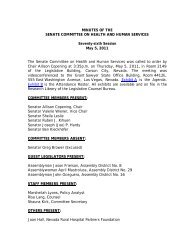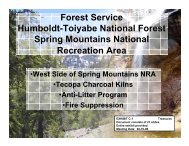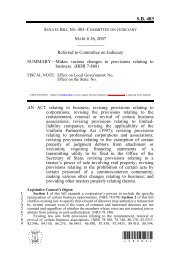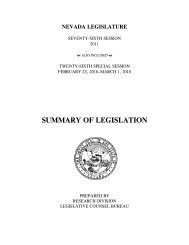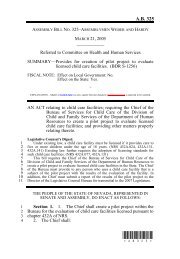Nevada Pre-Kindergarten Standards
Nevada Pre-Kindergarten Standards
Nevada Pre-Kindergarten Standards
You also want an ePaper? Increase the reach of your titles
YUMPU automatically turns print PDFs into web optimized ePapers that Google loves.
Content Standard 3.0: Identification and Expression of Feelings<br />
Indicator SE=Social Emotional<br />
3.PK.1 Identify a range of feelings (e.g., sadness, anger,<br />
fear, and happiness).<br />
3.PK.2a Express feelings, needs or wants in appropriate ways.<br />
3.PK.2b Demonstrate awareness of feelings of<br />
others (e.g., gets blanket for friend and comforts him/her<br />
when he/she feels sad).<br />
Content Standard 4.0: Interactions with other children and adults<br />
Indicator SE=Social Emotional<br />
4.PK.1a Demonstrate appropriate affection for teachers<br />
and friends.<br />
4.PK.1b Express common courtesy to others (e.g.,<br />
saying “thank you”, “please” and “excuse me”, or passing<br />
a plate of cookies).<br />
4.PK.1c Respect rights and belongings of others<br />
(e.g., “It is my turn to use the bike, but you can have the<br />
bike when I am finished”).<br />
4.PK.1d Demonstrate problem-solving skills (e.g. ask for<br />
help from an adult, talk about problems, talk about feelings<br />
relating to problems, and negotiate solutions).<br />
4.PK.1e Be able to say and respond to first and last name.<br />
4.PK.1f Be able to say parent’s or caregiver’s name.<br />
Social Studies/Social Emotional<br />
Examples: Children will/may...<br />
Identify a variety of feelings (e.g., anger,<br />
sadness, fear, happiness).<br />
Express feelings, needs, or wants in<br />
appropriate ways.<br />
Show an awareness of feelings in others and<br />
may comfort friends or others when needed.<br />
Show empathy for a friend or someone<br />
who is sad.<br />
Understand why someone is upset and try<br />
to help them to feel better.<br />
Examples: Children will/may...<br />
Show affection towards adults and friends.<br />
Express common courtesy to others<br />
(e.g., “please,” “thank you,” “excuse me”).<br />
Respect the rights and belongings of<br />
others (e.g., taking turns).<br />
Show problem solving skills (e.g., ask<br />
for help, talk about feelings, talk about<br />
problems, and negotiate solutions with<br />
others).<br />
Begin to share and invite other children to<br />
join in their play.<br />
Have a preferred playmate or prefer<br />
to play alone.<br />
Be able recite their full name when asked.<br />
Supportive Practice: Practitioner/Adult will…<br />
Create an environment where children feel<br />
safe and secure and where their feelings are<br />
accepted.<br />
Encourage children to evaluate themselves<br />
(e.g., “Was that easy or hard for you?”).<br />
Celebrate the children’s accomplishments.<br />
Respect and accept children and help<br />
him/her feel unique and special.<br />
Engage in frequent conversation with<br />
children about their interests, activities,<br />
feelings, and perspectives.<br />
Supportive Practice: Practitioner/Adult will…<br />
Model trust, honesty, and respect in<br />
dealings with children and adults.<br />
Use books to help children take the<br />
perspective of others and/or help with<br />
problem solving.<br />
Model the words and behaviors of<br />
politeness and common courtesy.<br />
Provide many opportunities for sharing.<br />
Support and model empathy.<br />
Point out and celebrate similarities and<br />
differences between children and families.<br />
Provide opportunities for children to<br />
learn and share names of their friends<br />
and families.<br />
49




